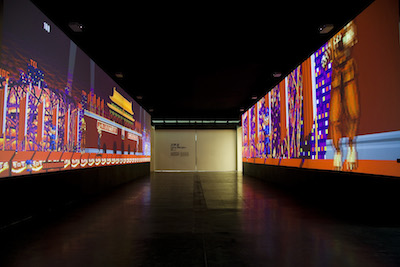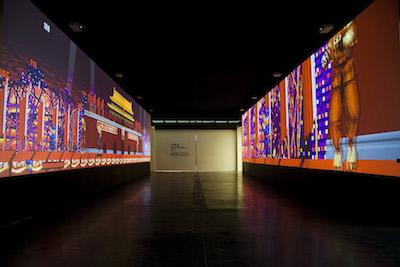Best known for his video-based art, Feng Mengbo was the first Chinese artist invited to exhibit at documenta in 1997 (and again in 2002). He also participated in the Venice Biennale in 1993 and, 10 years later, in the first official Chinese Pavilion of the Biennale. Initially materialized as a series of oil paintings of “game snapshots,” the video game Long March: Restart took Feng 15 years to complete.
The game’s narrative is loosely based on the historical Long March, a two-year military retreat by the Red Army between 1933 and 1935 that enabled it to avoid elimination by Chiang Kai-shek’s Kuomingtang (known as KMT) and decisively secured Mao Zedong’s (Mao Tse-tung) leading position in the Communist Party. Indisputably among the best-known episodes in China’s recent history, the Long March has been widely publicized and glorified by the Communist Party to propagate and secure its ruling. With a lighthearted and humorous approach, Feng distills the entire Red Army into a single soldier who sweeps through a myriad of obstacles, armed only with cans of Coca-Cola.
 Feng Mengbo, Long March: Restart, 2008, purchased with funds provided by Jane and Marc Nathanson, Ann Colgin and Joe Wender, Mary and David Solomon, Carolyn and John Diemer, and Bryan Lourd through the 2014 Collectors Committee, © image: Feng Mengbo
Feng Mengbo, Long March: Restart, 2008, purchased with funds provided by Jane and Marc Nathanson, Ann Colgin and Joe Wender, Mary and David Solomon, Carolyn and John Diemer, and Bryan Lourd through the 2014 Collectors Committee, © image: Feng Mengbo
In this “side-scroller” video game, a player moves along with, or even chases after, his/her avatar of the digital Red Army soldier, projected onto the wall at life-size scale. Like the soldiers of the 1930s who crossed some of the most difficult terrain of China, Feng’s Red Army soldier fights his way through marshes, snowy mountains, and iron-chain bridges. The artist also added new twists to stage the battles in classic video games such as Super Mario Bros and Street Fighter. At the end of 14 hard-fought stages, he finally triumphs in front of Tiananmen. Meaning “the Gate of Heavenly Peace,” Tiananmen is a symbol of supreme power and sovereignty. In ancient times, it marked the entrance to the Forbidden City where emperors resided. In was here in 1949 that Mao Zedong announced the founding of the People’s Republic of China. The digital Red Army soldier declares his victory and power at the same location. Immersed in large-scale projections to the soundtrack of revolutionary songs rendered in the style of vintage 8‑bit gaming music, the player becomes (un)consciously identified with the Red Army soldier, adding a contemporary critique to the canonization and politicization of history and its usage as propaganda. Coca‑Cola, the first Western consumer product introduced to China in 1979 after the country reopened its doors to the outside world, is at the same time a symbol of China’s own modernization and of the influx of influences from the West. Humorous, witty, and even cynical, Feng’s Long March: Restart comments simultaneously on the two most important historical moments in 20th-century China.
With the dramatic developments taking place in China in the past decades, artists are frequently among the most active and critical commentators of the social and economic changes that have transformed the country. Feng’s Long March: Restart is one of the most iconic artworks created by a Chinese artist in the past 30 years. Using modern technology, it seamlessly connects and comments on China’s history and current society.
Christina Yu Yu, Assistant Curator, Chinese Art



